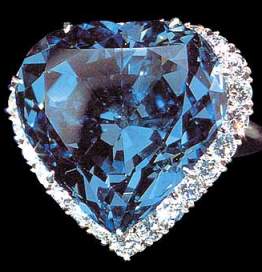However, this mystery has been solved and more information about the diamond has been unearthed, thanks to the untiring efforts of the dedicated scientists of the Natural History Museum of the Smithsonian Institution, the present owners of the diamond. The researches went into the archives of De Beers, and unearthed evidence to show that the diamond was discovered in the Premier diamond mines of South Africa, in November, 1908, and the rough stone weighed 102 carats. The rough stone was eventually cut and polished in Paris as stated earlier and sold to Cartier's, who set the diamond in a "Lily of the Valley" corsage and sold it to an Argentinean woman Mrs. Unzue. The diamond remained in the Unzue family until 1953, when it was purchased by the jewelry firm Van Cleef & Arpels, who dismantled the corsage setting, and re-set the diamond in a pendant, surrounded by 25 colorless or white diamonds. The pendant and the accompanying necklace was priced at $ 300,000, and was sold to an unnamed European titled family. In 1959, Harry Winston acquired the diamond, and re-set it again in a platinum ring and sold it to Marjorie Merriweather Post. The diamond remained with Mrs. Post until the 1960s, when she finally decided to donate the rare blue diamond to the Natural History Museum of the Smithsonian Institution, at Washington DC, where it is on display in the Janet Annenberg Hooker Hall of Geology, Gems and Minerals, in the National Museum of Natural History.
Natural blue diamonds surpass all other gemstones for their sheer beauty, and it is this uniqueness in their beauty combined with their rarity, that make them the most sought after diamonds by collectors and connoisseurs, around the world. The sale of a rare fancy vivid blue diamond weighing 6.04 carats at a Sotheby's auction in Hong Kong, on October 8, 2007, for a record-breaking price of 7.98 million, therefore comes as little surprise to those in the trade and the well informed. The $ 1.32 million per carat price of this diamond has broken the 20-year old world record, set by the Hancock Red (Halphen Red) diamond in 1987, which sold at $ 926,000 per carat. The diamond is reported to have been purchased by Moussaieff Jewelers of London, who in 2001 purchased another extremely rare 5.11-carat red diamond known as the "Red Shield," for an undisclosed amount, from the William Goldberg Corporation of New York. The Red Shield was subsequently re-named the "Moussaieff Red," which is the largest red diamond in the world.


No comments:
Post a Comment